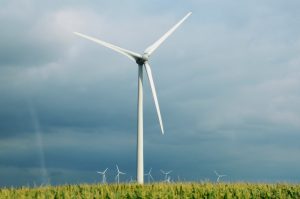Since the dawn of time, man has used wind energy to power various types of machines, and for over half a century, it has been used to generate electricity. Despite their age, the first wind farms can still be considered modern. Can they be considered the technology of the future?

The history of the bond between wind and man
The first mention of the use of wind dates back to around 3000 BC. It comes from Egypt and talks about the use of wind to propel boats (through their sails, as we can easily guess). Reliable historical records regarding windmills date back to 644 CE. They talk about windmills from the Persian-Afghan border of Seistan. For a long time, they were mainly used to power various types of machines. The first wind turbine generating electricity was built at the turn of 1887 and 1888. Its designer was Charles F. Brush, one of the pioneers of the American electrical industry. Its construction, however, still did not resemble the wind farms we know today. The first such AC power plant was built in 1957 by Johannes Juul. It was constructed off the coast of Denmark and, even by today’s standards, its assumptions are quite modern (the structure itself). It was this event that could be considered the beginning of what we know today as wind farms.
Natural electricity
Due to the ongoing climate crisis, more and more attention is paid to renewable energy sources (RES). Wind farms are obviously counted among them. Their advantages include low cost of obtaining energy – the average cost of one kilowatt-hour does not exceed PLN 0.10. Moreover, the operation of wind farms does not generate greenhouse gases. The energy generated in this way does not need to be imported. This factor has a large impact on the environment, as fossil fuels often have to be imported, which generates a lot of pollution during transport, not to mention the devastating environmental impact during their extraction and combustion. Whereas, the energy generated from the wind is the complete opposite – it is considered to be one of the cleanest both due to the lack of harmful substances generated during wind farm operation and the materials used in their construction.
Eco-construction that provides eco-energy
The foundations of most wind farms are made of concrete. Concrete of appropriate quality makes the structure durable and does not require expensive interventions for a very long time. This means that apart from the production process (which is constantly modernized), the use of such a power plant does not generate additional pollution. You do not need a large area of land for its construction – despite the height, they do not take up much space. Increasingly, you can also observe smaller windmills that can power individual buildings.
In summary, wind farms can turn out to be an excellent future-proof solution for energy production. Their advantages include emission-free operation, low cost of obtaining energy and durability associated with the use of concrete. The PCC Group offers the manufacturers of concrete and concrete-based elements modern additives. See the Product Portal for our complete offer.
References:
http://www.instsani.pl/413/historia-energetyki-wiatrowej
https://justenergy.com/blog/wind-energy-pros-and-cons/
https://www.conserve-energy-future.com/pros-and-cons-of-wind-energy.php
https://www.energysage.com/about-clean-energy/wind/pros-cons-wind-energy/
https://www.energy.gov/eere/wind/advantages-and-challenges-wind-energy